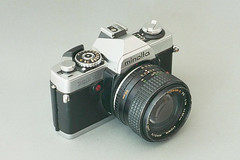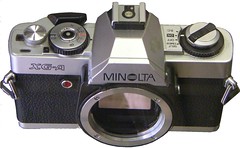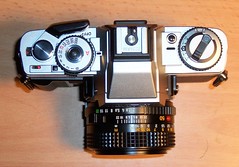Difference between revisions of "Minolta XG series"
m |
m |
||
| Line 2: | Line 2: | ||
== Minolta XG-E == | == Minolta XG-E == | ||
| − | The '''XG-E''' ('''XG | + | The '''XG-E''' ('''XG 7''' in USA and Canada, '''XG 2''' in Europe and elsewhere) was the first model of this series to be introduced in 1977. The XG-E was available in black finish only, while the XG 7 and XG 2 were available in chrome and black finish. |
=== Body and features === | === Body and features === | ||
| − | The XG-E was considerably smaller and lighter than the recent cameras like the [[Minolta XE|XE]] or [[Minolta SR-T 101|SR-T]] series. It featured a center weighting metering system with two CdS cells and a Matte-Fresnell-field focusing screen with a horizontal split-image spot surrounded by a microprism field. The viewfinder showed the automatic shutter times from 1s to 1/1000s via LEDs. Unfortunately in manual mode the LED didn't show the meterd shutter time. The shutter dial showed the manual times from 1s to 1/1000s, B and A for aperture priority and it allowed the ASA setting. In order to override the automatic chosen speed, the dial could be turned so that the A faced a number between -2 and +2 in full stops. The back with a memory holder and a DIN/ASA conversion scale was interchangeable with the later available '''Data Back G'''. The bottom of the camera showed a coupling for the '''Winder G''', which was introduced with the camera. The main power switch has a self timer setting, which delays the shutter actuation for approximately 10 seconds. Until the shutter fired, a red light on the front side started flashing. The same light was used for the B.C. (battery check) setting of the main switch. The flash shoe was the same as with the XD series and had a second small contact. This contact synchronized the camera to a dedicated Minolta X-Flash like the '''Auto Electroflash 200X'''. In A mode with powered up flash in the shoe, the camera automatically set the shutter time to 1/60s. Besides the X-contact in the flash shoe, it had a flash terminal at the lens bayonet. Next to it was a socket for an electronic cable release like '''Remote Cord S''' or '''L''' or a mechanical cable release. The camera didn't have a stop down button. | + | The XG-E was considerably smaller and lighter than the recent cameras like the [[Minolta XE|XE]] or [[Minolta SR-T 101|SR-T]] series. It featured a center weighting metering system with two CdS cells and a Matte-Fresnell-field focusing screen with a horizontal split-image spot surrounded by a microprism field. The viewfinder showed the automatic shutter times from 1s to 1/1000s via LEDs. Unfortunately in manual mode the LED didn't show the meterd shutter time. In automatic mode the camera blocked the shutter, if the triangular overexposure LEDs (at the top end of the LED sacle) indicated a shutter time shorter than 1/1000s. The shutter dial showed the manual times from 1s to 1/1000s, B and A for aperture priority and it allowed the ASA setting. In order to override the automatic chosen speed, the dial could be turned so that the A faced a number between -2 and +2 in full stops. The back with a memory holder and a DIN/ASA conversion scale was interchangeable with the later available '''Data Back G'''. The bottom of the camera showed a coupling for the '''Winder G''', which was introduced with the camera. The main power switch has a self timer setting, which delays the shutter actuation for approximately 10 seconds. Until the shutter fired, a red light on the front side started flashing. The same light was used for the B.C. (battery check) setting of the main switch. The flash shoe was the same as with the XD series and had a second small contact. This contact synchronized the camera to a dedicated Minolta X-Flash like the '''Auto Electroflash 200X'''. In A mode with powered up flash in the shoe, the camera automatically set the shutter time to 1/60s and the blinking LED served as a flash ready signal. Besides the X-contact in the flash shoe, it had a flash terminal at the lens bayonet. Next to it was a socket for an electronic cable release like '''Remote Cord S''' or '''L''' or a mechanical cable release. The camera didn't have a stop down button. |
=== Aperture priority and Manual mode === | === Aperture priority and Manual mode === | ||
| − | The [[Minolta]] XG | + | The [[Minolta]] XG 1 was a dual mode camera. It had an aperture priority mode "A" which obviously is metered. Metering is done by half depressing the shutter button. The shutterspeed then selected by the camera is shown in the viewfinder by a red LED. In the "A" mode you can "force" the camera to under- or overexpose your pictures by up to two stops. In situations requiring to fast a shutterspeed, faster than 1/1000s, the camera will not fire to prevent overexposure. This is indicated by a red triangle in the viewfinder. Stop down the lens untill a shutterspeed is shown and you're ready to shoot again. |
Curiously, the manual mode is non-metered. Reviews on the web suggest Minolta wanted to avoid confusion. The XG-M, a later model in the XG series, had a metered manual mode with a little red "M" warning the user he was not in the "A" mode. | Curiously, the manual mode is non-metered. Reviews on the web suggest Minolta wanted to avoid confusion. The XG-M, a later model in the XG series, had a metered manual mode with a little red "M" warning the user he was not in the "A" mode. | ||
| − | == Minolta XG | + | == Minolta XG 1 == |
The '''XG-1''' was the second to appear in the XG series in 1979. It was basicly a XG-2 with a less informative finder display and a non-detachable back door. It was available in chrome finishing only and was an export model, which wasn't sold in Japan. | The '''XG-1''' was the second to appear in the XG series in 1979. It was basicly a XG-2 with a less informative finder display and a non-detachable back door. It was available in chrome finishing only and was an export model, which wasn't sold in Japan. | ||
| Line 22: | Line 22: | ||
Besides the fixed back door, the XG-1 had a simplified viewfinder read out: The range between 1/15s and 1/2s was now represented by one LED. Further it lacked the memo holder and had just a DIN/ASA conversion scale instead. | Besides the fixed back door, the XG-1 had a simplified viewfinder read out: The range between 1/15s and 1/2s was now represented by one LED. Further it lacked the memo holder and had just a DIN/ASA conversion scale instead. | ||
| − | In early 1982 it got the new "rising sun" logo on the prism cover. Later that year | + | === Versions === |
| + | |||
| + | In early 1982 it got the new "rising sun" logo on the prism cover. Later that year, the XG-1 was replaced by the '''XG-1(n)''' with a new body design. Internally it was equiped with the "Acute Matte" focusing screen and a red M lighting in the viewfinder when leaving the auto mode. Although in manual mode, the meter is not working. The XG-1(n) finally got the memo holder on the back door. | ||
<br clear ="all"> | <br clear ="all"> | ||
| Line 36: | Line 38: | ||
== Minolta XG-SE == | == Minolta XG-SE == | ||
| − | The '''XG-SE''' was a rebagded XG-1 in black finish. It is reported, that the "SE" stands for "Special Edition". Maybe it was supposed to satisfy the demand for a professionel looking (black finished) entry model. Like the XG-1 it was an export model. | + | The '''XG-SE''' was a rebagded [[Minolta XG series#Minolta XG-1|XG-1]] in black finish, hitting the shelves shortly after the XG-1. It is reported, that the "SE" stands for "Special Edition". Maybe it was supposed to satisfy the demand for a professionel looking (black finished) entry model. Like the XG-1 it was an export model. |
| − | == Minolta XG- | + | == Minolta XG-S == |
<div class="floatright" style="text-align:center;"><div style="border:black 2px solid">http://www.ukcamera.com/collect/images/minoltaxg9.jpg</div>Minolta XG-9</div> | <div class="floatright" style="text-align:center;"><div style="border:black 2px solid">http://www.ukcamera.com/collect/images/minoltaxg9.jpg</div>Minolta XG-9</div> | ||
| + | |||
| + | In late 1979 Minolta revealed the '''XG-S'''. Outside Japan, this model was known as '''XG-9''', and with its improvements, it addressed some weak points of the XG-2, which it replaced. While the japanese XG-S was available in black only, the customers in the rest of the world had the choice between chrome and black finish. | ||
| + | |||
| + | === Body and features === | ||
| + | |||
| + | The XG-S had all features, the [[Minolta XG series#Minolta XG-E|XG-E]] had, but added or changed the following points: | ||
| + | |||
| + | * The viewfinder showed the set aperture at the bottom | ||
| + | * A stop down button was added | ||
| + | * The new and much brighter "Acute Matte" focusing screen preplaced the fresnel field screen | ||
| + | |||
| + | This was a big leap ahead and left only one major draw back of all XG models untouched: The non-working meter read out in manual mode. | ||
| + | |||
| + | <br clear ="all"> | ||
| + | == Minolta X-7 == | ||
| + | |||
| + | In early 1980 Minolta released the X-7 for the domestic market. It can be seen as an even more stripped down version of the [[Minolta XG series#Minolta XG-1|XG-1]]. It lacked the manuel shutter times and the DIN/ASA conversion scale on the film door. The shutter dial showed only the Auto setting with a overriding scale from -2 to +2, B and X. | ||
| + | |||
| + | |||
<br clear ="all"> | <br clear ="all"> | ||
Revision as of 00:30, 20 December 2006
The Minolta XG is a series of 35mm SLR cameras that was sold from 1977 to 1984. It was launched together with the way more sophisticated Minolta XD series in 1977 as a budget line of small, lightweight and easy to use electronic SLR with an automatic exposure mode. As a first in the line up of Minolta SLRs, these cameras were inoperable without a battery. They still used the outdated CdS metering system and had a competitive cloth shutter. In the aperture priority automatic mode, the electronically gouverned shutter provided stepless speeds from 1s to 1/1000s. The big news was the so called "Touch Switch": After powering the camera up via the main switch, it was in a stand-by mode. If the photographer just slightly touched the release button, he activated the electronics and the LEDs lighted up for about 15 seconds. All XG bodies featured an ±2 EV exposure compensation. The XG series had a dedicated motor drive, the Winder G and the flagship of the series, the XG-M, even could be mounted on the 3.5-fps Motor Drive 1. Also a data back, the Data Back G was available. This series can be seen as the ancestor of the most successfull of all manual Minolta SLRs, the famous Minolta X-700.
Contents
Minolta XG-E
The XG-E (XG 7 in USA and Canada, XG 2 in Europe and elsewhere) was the first model of this series to be introduced in 1977. The XG-E was available in black finish only, while the XG 7 and XG 2 were available in chrome and black finish.
Body and features
The XG-E was considerably smaller and lighter than the recent cameras like the XE or SR-T series. It featured a center weighting metering system with two CdS cells and a Matte-Fresnell-field focusing screen with a horizontal split-image spot surrounded by a microprism field. The viewfinder showed the automatic shutter times from 1s to 1/1000s via LEDs. Unfortunately in manual mode the LED didn't show the meterd shutter time. In automatic mode the camera blocked the shutter, if the triangular overexposure LEDs (at the top end of the LED sacle) indicated a shutter time shorter than 1/1000s. The shutter dial showed the manual times from 1s to 1/1000s, B and A for aperture priority and it allowed the ASA setting. In order to override the automatic chosen speed, the dial could be turned so that the A faced a number between -2 and +2 in full stops. The back with a memory holder and a DIN/ASA conversion scale was interchangeable with the later available Data Back G. The bottom of the camera showed a coupling for the Winder G, which was introduced with the camera. The main power switch has a self timer setting, which delays the shutter actuation for approximately 10 seconds. Until the shutter fired, a red light on the front side started flashing. The same light was used for the B.C. (battery check) setting of the main switch. The flash shoe was the same as with the XD series and had a second small contact. This contact synchronized the camera to a dedicated Minolta X-Flash like the Auto Electroflash 200X. In A mode with powered up flash in the shoe, the camera automatically set the shutter time to 1/60s and the blinking LED served as a flash ready signal. Besides the X-contact in the flash shoe, it had a flash terminal at the lens bayonet. Next to it was a socket for an electronic cable release like Remote Cord S or L or a mechanical cable release. The camera didn't have a stop down button.
Aperture priority and Manual mode
The Minolta XG 1 was a dual mode camera. It had an aperture priority mode "A" which obviously is metered. Metering is done by half depressing the shutter button. The shutterspeed then selected by the camera is shown in the viewfinder by a red LED. In the "A" mode you can "force" the camera to under- or overexpose your pictures by up to two stops. In situations requiring to fast a shutterspeed, faster than 1/1000s, the camera will not fire to prevent overexposure. This is indicated by a red triangle in the viewfinder. Stop down the lens untill a shutterspeed is shown and you're ready to shoot again.
Curiously, the manual mode is non-metered. Reviews on the web suggest Minolta wanted to avoid confusion. The XG-M, a later model in the XG series, had a metered manual mode with a little red "M" warning the user he was not in the "A" mode.
Minolta XG 1
The XG-1 was the second to appear in the XG series in 1979. It was basicly a XG-2 with a less informative finder display and a non-detachable back door. It was available in chrome finishing only and was an export model, which wasn't sold in Japan.
Body and features
Besides the fixed back door, the XG-1 had a simplified viewfinder read out: The range between 1/15s and 1/2s was now represented by one LED. Further it lacked the memo holder and had just a DIN/ASA conversion scale instead.
Versions
In early 1982 it got the new "rising sun" logo on the prism cover. Later that year, the XG-1 was replaced by the XG-1(n) with a new body design. Internally it was equiped with the "Acute Matte" focusing screen and a red M lighting in the viewfinder when leaving the auto mode. Although in manual mode, the meter is not working. The XG-1(n) finally got the memo holder on the back door.
Pictures of the XG-1
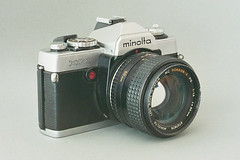 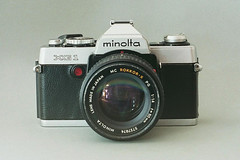 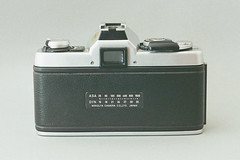
|
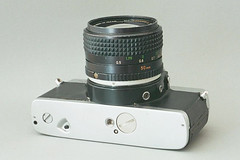 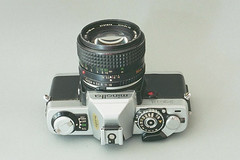
|
Minolta XG-SE
The XG-SE was a rebagded XG-1 in black finish, hitting the shelves shortly after the XG-1. It is reported, that the "SE" stands for "Special Edition". Maybe it was supposed to satisfy the demand for a professionel looking (black finished) entry model. Like the XG-1 it was an export model.
Minolta XG-S
In late 1979 Minolta revealed the XG-S. Outside Japan, this model was known as XG-9, and with its improvements, it addressed some weak points of the XG-2, which it replaced. While the japanese XG-S was available in black only, the customers in the rest of the world had the choice between chrome and black finish.
Body and features
The XG-S had all features, the XG-E had, but added or changed the following points:
- The viewfinder showed the set aperture at the bottom
- A stop down button was added
- The new and much brighter "Acute Matte" focusing screen preplaced the fresnel field screen
This was a big leap ahead and left only one major draw back of all XG models untouched: The non-working meter read out in manual mode.
Minolta X-7
In early 1980 Minolta released the X-7 for the domestic market. It can be seen as an even more stripped down version of the XG-1. It lacked the manuel shutter times and the DIN/ASA conversion scale on the film door. The shutter dial showed only the Auto setting with a overriding scale from -2 to +2, B and X.
Minolta XG-A
The Minolta XG-A was the simplest of the XG series. It is a manual focus SLR camera body with automatic control of shutter speed. Its predecessor, the XG-1, had a full scale manual mode; the XG-A had only a selector for under- or over-exposure (seen in the photograph).
Minolta XG-M
